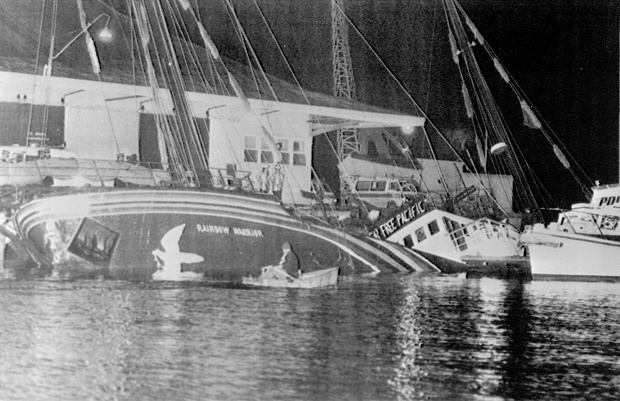
In this July 10, 1985 file photo, the Greenpeace ship Rainbow Warrior is seen after it was sank in Auckland harbor, after explosions on board. A retired French secret service agent who says he planted the bombs 30 years ago which sank a Greenpeace ship and killed a photographer has apologized. Jean-Luc Kister told Television New Zealand Sunday, Sept. 6, 2015, that he and his colleagues never meant to kill anybody when they attached two bombs to the Rainbow Warrior on July 10, 1985, while the boat was moored in Auckland. AP
WELLINGTON, New Zealand — A retired French secret service agent has apologized for planting the bombs which sank a Greenpeace ship 30 years ago, killing a photographer and causing an international incident that tarnished the image of France.
Jean-Luc Kister told Television New Zealand on Sunday that he and his colleagues never meant to kill anybody when they attached two bombs to the Rainbow Warrior on July 10, 1985, while the boat was moored in Auckland.
The boat was to travel to French Polynesia to protest French nuclear testing. The bombing killed 35-year-old Portuguese-born photographer Fernando Pereira, who drowned.
Kister said their intention was only to sink the boat, and the death has plagued his conscience ever since. He described the operation as a “big, big failure.”
“We were not cold-blooded killers,” Kister said. “We did everything to preserve life of the people on board of the Rainbow Warrior.”
He said he was surprised when he got the orders to bomb the Greenpeace boat, an organization he considered to be made up of troublemakers but not very dangerous.
“For us, it was just like using boxing gloves in order to crush a mosquito,” he told TVNZ.
He said he was told Greenpeace had been infiltrated by Russian KGB agents.
Kister, who was an agent with France’s Direction Generale de la Securite Exterieure, said he was the diver who attached the bombs to the ship’s hull. He directed his apology to the photographer’s daughter.
“I would like to take this opportunity given to me by the TV of New Zealand to express my deepest regrets,” he said. “And apologize to Ms. Marelle Pereira and her family for the accidental death of Fernando Pereira.”
“I want to apologize to the people of New Zealand for the unfair, clandestine operation, conducted on an ally, a friendly and peaceful country,” he said.
Greenpeace New Zealand’s Executive Director Bunny McDiarmid said it is good to hear the apology but she believes the French agents acted recklessly. McDiarmid was a deckhand on the Rainbow Warrior but was not aboard at the time of the bombing.
“I think it’s nice that someone from that murderous fiasco apologies, and recognizes what they did was illegal and immoral,” McDiarmid said. “But the apology is so conditioned. Does he expect people to believe they didn’t mean to hurt anybody? I think they were indifferent to that.”
Peter Willcox, the captain of the Rainbow Warrior at the time, expressed similar reservations. In a Facebook post, he said he thought Kister’s apology was sincere but that the agents were indifferent to any deaths that might occur.
“This was a highly trained military team. Could they really have been that bad at their job?” Willcox wrote. “They could have used, and I am guessing here, one quarter of the explosives, and sunk the boat, giving us time to get off.”
The incident has remained a source of tension between France and New Zealand. French agents Dominique Prieur and Alain Mafart were caught in New Zealand after the bombing and pleaded guilty to manslaughter.
But both were repatriated to France within three years, a move which upset many New Zealanders who believed their government had capitulated to French pressure.